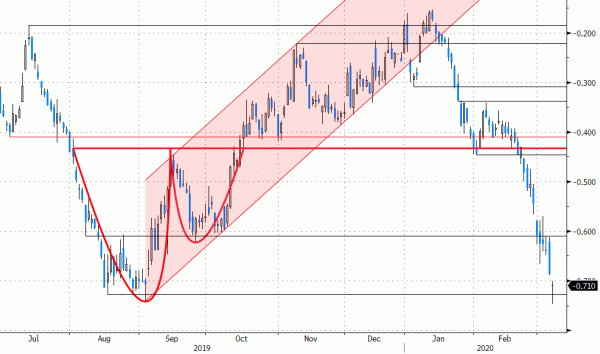- Rates: US 10-yr yield dives below 0.5%
A fuming Saudi reaction to last week’s failed OPEC+ meeting sends oil prices in tail spin this morning (low $30/barrel). US yields plunge by another 20 to 50 bps, flattening the curve. The market now discounts a 75 bps rate cut in March. Expect double trouble in Europe with markets having to react to draconic Italian quarantine measures as well. - Currencies: EUR/USD jumps into ‘new era’ on broad USD sell-off
On Friday, EUR/USD jumped north of the 1.1250 key resistance, further improving the technical picture. During the weekend, the corona crisis was further complicated by an oil price crisis. In line with recent market paradigm shift, it doesn’t hem the dollar, to the contrary.
The Sunrise Headlines
- WS tumbled up to 1.87% (Nasdaq) as investors fled headlong to safe havens amid worries over the economic trauma of the coronavirus. Asian markets nosedive following a full-blown oil price-war. Australia underperforms (-7.33%).
- Saudi Arabia fired shots slashing oil prices and planning to raise its production significantly after OPEC+ talks collapsed as Russia refused to bend to output cuts. Oil prices went into freefall, posting the steepest drop since 1991.
- The Fed’s Rosengren announced the CB should consider widening the range of assets it can buy if it would continue its QE programme as other tools could fail to provide a significant economic boost given the steep drop in treasury yields.
- The German government announced financial plans to counter the economic fallout of the coronavirus. The government loosened rules for short-term work compensation and will invest an additional €12.4bn between 2021 and 2024.
- UK’s finance minister Rishi Sunak signalled he’s looking at ways to relax UK’s budget limits as he prepares a massive package of measures to tackle the coronavirus crisis and shore up the economy.
- Chinese exports plunged in January and February by a more-than-anticipated 17.2% in dollar terms while imports dropped by 4% as the coronavirus outbreak led to extended holidays and depressed demand and factory output.
- Today’s economic calendar eyes meagre with only secondary data due in Europe. Recession fears and Saudi-Arabia’s shock-and-awe response to the OPEC+ fiasco will be driving market themes
Currencies: EUR/USD Jumps Into ‘New Era’ On Broad USD Sell-Off
Oil crisis only reinforces USD sell-off
On Friday, the risk-off correction simply continued according to the ‘new’ standard script. In this ‘new paradigm’ the presumed safe haven dollar has no big role to play when equities and (US) yields nosedive. To the contrary. The loss of interest rate support propelled EUR/USD north of the 1.1239/50 resistance (close at 1.1284 from an open of 1.1238). USD/JPY also trended further south (close 105.39). Strong US payrolls were seen as outdated and didn’t help the dollar in any meaningful way.
This morning, the market sell-off is shifting into a higher gear as the corona crisis is reinforced by an oil crisis. Russia didn’t join the OPEC+ production cut. Saudi Arabia (and Russia) started an oil price war that is heavily destabilizing Asian markets this morning with regional equities declining from 2.5% (China) to 7.3% (Australia). The dollar is again hit hard. The trade-weighted-dollar (DXY) hit the 95 barrier this morning. USD/JPY filled bids well below 102 (currently 102.71). In volatile trade, EUR/USD came within reach of 1.15 (currently 1.1405 area). The yuan initially strengthened, but completely reversed earlier gains (USD/CNY 9.94 area).
Later today, the corona and oil crisis will continue to guide global FX trading. European (equity) markets will face an extremely difficult start, with plenty of headlines about Italy. However, in relative terms, the oil crisis might be an even bigger problem for the US. So, there is little reason to assume that the dollar will be able to take up its previous safe haven status. The upcoming ECB meeting might also illustrate the bank’s inability to act. EUR/USD is moving into overbought territory, but in the current environment, we don’t row against the (USD-negative) tide. 1.1250/1.1620 might be a new trading range. We don’t anticipate a sustained USD rebound yet. By default euro (and yen) strength might persist.
EUR/GBP jumped temporarily north of 0.87 as markets pondered the fiscal response of the UK government to the coronacrisis, but sterling rebounded later in the session. During the weekend, UK Fin Min Sunak was reported to consider ways to create flexibility in the budget rules. However, for now, the global riskoff still weighs on sterling. We expect sterling to stay in the defensive against the euro.
EUR/USD: USD enters ST consolidation pattern, but permanent loss of interest rate support makes comeback difficult.













